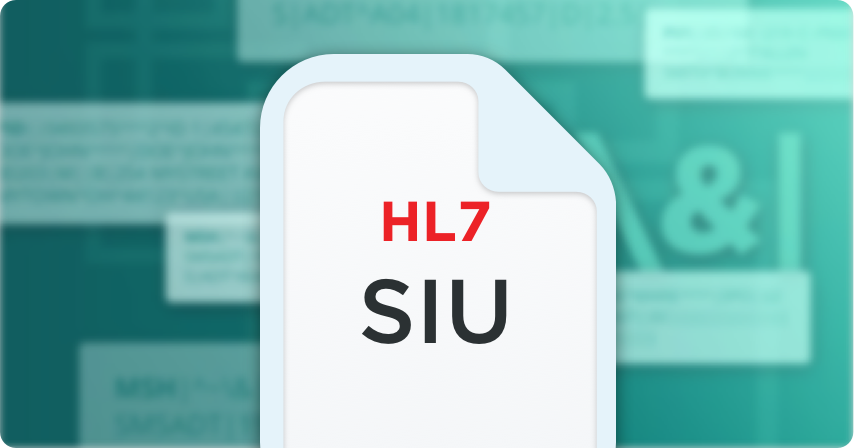
HL7 SIU
Appointment Scheduling
HL7 Scheduling Information Unsolicited (SIU) messages are used to exchange patient appointment schedule information between clinical and administrative systems.
SIU (Scheduling Information Unsolicited)
Typically, HL7 SIU messages are generated by the hospital scheduling system and sent to a clinic or physician practice to request, reschedule, cancel or update outpatient services and provide updated patient medical record information.
There are 14 different trigger events for the SIU message, each sharing the same message format.
- SIU^S12 – Notification of New Appointment Booking
- SIU^S13 – Notification of Appointment Rescheduling
- SIU^S14 – Notification of Appointment Modification
- SIU^S15 – Notification of Appointment Cancellation
- SIU^S16 – Notification of Appointment Discontinuation
- SIU^S17 – Notification of Appointment Deletion
- SIU^S18 – Notification of Addition of Service/Resource on Appointment
- SIU^S19 – Notification of Modification of Service/Resource on Appointment
- SIU^S20 – Notification of Cancellation of Service/Resource on Appointment
- SIU^S21 – Notification of Discontinuation of Service/Resource on Appointment
- SIU^S22 – Notification of Deletion of Service/Resource on Appointment
- SIU^S23 – Notification of Blocked Schedule Timeslot(s)
- SIU^S24 – Notification of Opened (“un-blocked”) schedule time slot(s)
- SIU^S26 – Notification that Patient did not show up for Scheduled Appointment

Sample SIU Message
Shown below is an example of an HL7 version 2.3 SIU^12 message, notifying the receiving application of a new appointment booking:
SCH|10345^10345|2196178^2196178|||10345|OFFICE^Office visit|reason for the appointment|OFFICE|60|m|^^60^20110617084500^20110617093000|||||9^DENT^ARTHUR^||||9^DENT^COREY^|||||Scheduled
PID|1||42||SMITH^PAUL||19781012|M|||1 Broadway Ave^^Fort Wayne^IN^46804||(260)555-1234|||S||999999999|||||||||||||||||||||
PV1|1|O|||||1^Smith^Miranda^A^MD^^^^|2^Withers^Peter^D^MD^^^^||||||||||||||||||||||||||||||||||||||||||99158||
RGS|1|A
AIG|1|A|1^White, Charles|D^^
AIL|1|A|OFFICE^^^OFFICE|^Main Office||20110614084500|||45|m^Minutes||Scheduled
AIP|1|A|1^White^Charles^A^MD^^^^|D^White, Douglas||20110614084500|||45|m^Minutes||Scheduled
| Segment | Description |
|---|---|
| MSH | Message Header. The header contains information about the sending system and location, the receiving system and location, the date and time of when the message was created, the type of trigger event being communicated, and the HL7 message version being used. This segment is required. |
| SCH | Schedule Activity Information. Contains general information about the scheduled appointment. This segment is required. |
| PID | Patient Identification. Important patient identification information, including patient demographics. This segment is required. |
| [PV1] | Patient Visit. Contains information about patient visit details such as servicing facility, attending doctor, and visit ID. This segment is optional. |
| RGS | Resource Group. Identifies relationships between resources required for a scheduled event. Each group of RGS segments is followed by Appointment Information Segments. Every SIU message requires at least one RGS segment. |
| AIG | Appointment Information - General Resource. Captures information about resources that require scheduling through a schedule filler application. This segment is required. |
| AIL | Appointment Information - Location. Captures information about location resources such as rooms or other locations. This segment is required. |
| AIP | Appointment Information - Personnel Resource. Captures information about the healthcare personnel resources that require scheduling through a schedule filler application. This includes any type of healthcare provider at the institution. This segment is required. |
| [ ] = optional, { } = repeating | |
For more information on implementing various HL7 message types, please refer to the HL7 Messaging Standard Implementation Guides corresponding to your required version.
Working With SIU Messages
Are you working with HL7 SIU messages? In order to successfully process these messages, it's important to understand the specific format that the sending and receiving facilities are expecting the SIU messages to adhere to. Discrepancies can occur due to the version of HL7, system input error, or even simply human error when the messages were created.
How does Iguana ensure that SIU messages are properly formatted to ensure system compatibility?
Iguana is a data integration platform that allows you to easily customize the format, structure, and field values of your HL7 messages so that they are normalized, ensuring compatibility with any system you might need to interact with.
Other HL7 Message Types
- HL7 ADT (Admit, Discharge and Transfer)
- HL7 ORM (Order Entry)
- HL7 ORU (Observation Result)
- HL7 MDM (Medical Document Management)
- HL7 DFT (Detailed Financial Transactions)
- HL7 BAR (Billing Account Record)
- HL7 SIU (Scheduling Information Unsolicited)
- HL7 RDS (Pharmacy/treatment Dispense)
- HL7 RDE (Pharmacy/Treatment Encoded Order)
- HL7 ACK (Acknowledgement Message)